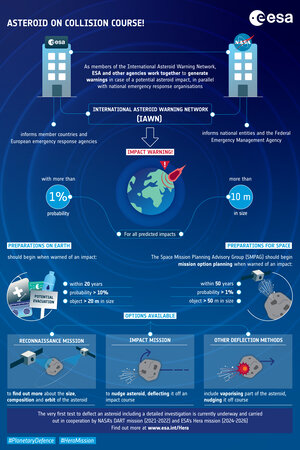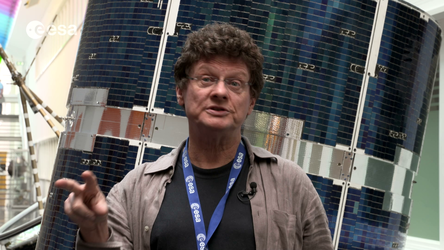Accept all cookies Accept only essential cookies See our Cookie Notice

About ESA
The European Space Agency (ESA) is Europe’s gateway to space. Its mission is to shape the development of Europe’s space capability and ensure that investment in space continues to deliver benefits to the citizens of Europe and the world.
Highlights
ESA - United space in Europe
This is ESA ESA facts Member States & Cooperating States Funding Director General Top management For Member State Delegations European vision European Space Policy ESA & EU Space Councils Responsibility & Sustainability Annual Report Calendar of meetings Corporate newsEstablishments & sites
ESA Headquarters ESA ESTEC ESA ESOC ESA ESRIN ESA EAC ESA ESAC Europe's Spaceport ESA ESEC ESA ECSAT Brussels Office Washington OfficeWorking with ESA
Business with ESA ESA Commercialisation Gateway Law at ESA Careers Cyber resilience at ESA IT at ESA Newsroom Partnerships Merchandising Licence Education Open Space Innovation Platform Integrity and Reporting Administrative Tribunal Health and SafetyMore about ESA
History ESA Historical Archives Exhibitions Publications Art & Culture ESA Merchandise Kids Diversity ESA Brand Centre ESA ChampionsLatest
Space in Member States
Find out more about space activities in our 23 Member States, and understand how ESA works together with their national agencies, institutions and organisations.
Science & Exploration
Exploring our Solar System and unlocking the secrets of the Universe
Go to topicAstronauts
Missions
Juice Euclid Webb Solar Orbiter BepiColombo Gaia ExoMars Cheops Exoplanet missions More missionsActivities
International Space Station Orion service module Gateway Concordia Caves & Pangaea BenefitsLatest
Space Safety
Protecting life and infrastructure on Earth and in orbit
Go to topicAsteroids
Asteroids and Planetary Defence Asteroid danger explained Flyeye telescope: asteroid detection Hera mission: asteroid deflection Near-Earth Object Coordination CentreSpace junk
About space debris Space debris by the numbers Space Environment Report In space refuelling, refurbishing and removingSafety from space
Clean Space ecodesign Zero Debris Technologies Space for Earth Supporting Sustainable DevelopmentLatest
Applications
Using space to benefit citizens and meet future challenges on Earth
Go to topicObserving the Earth
Observing the Earth Future EO Copernicus Meteorology Space for our climate Satellite missionsCommercialisation
ESA Commercialisation Gateway Open Space Innovation Platform Business Incubation ESA Space SolutionsLatest
Enabling & Support
Making space accessible and developing the technologies for the future
Go to topicBuilding missions
Space Engineering and Technology Test centre Laboratories Concurrent Design Facility Preparing for the future Shaping the Future Discovery and Preparation Advanced Concepts TeamSpace transportation
Space Transportation Ariane Vega Space Rider Future space transportation Boost! Europe's Spaceport Launches from Europe's Spaceport from 2012Latest

Tunguska devastation
Fallen trees at Tunguska, Imperial Russia, seen in 1929, 15 km from epicentre of aerial blast site, caused by explosion of a meteor in 1908 (Photo N. A. Setrukov, 1928).
Near-Earth objects are asteroids or comets, metres to tens of kilometres in size, that orbit the Sun and whose orbits come close to that of Earth’s. Of the more than 600 000 known asteroids in our Solar System, over 16 000 are classified as NEOs.
On 30 June 1908, above the skies of Tunguska in Russia, such an object 30–40 m in diameter and travelling at approximately 100 000 km/hour penetrated Earth's atmosphere.
It heated to approximately 10 000C and exploded between six and ten km above the ground. The blast released the equivalent energy of 10–15 megatons of TNT, destroying 2200 square km of forest and leaving few traces of life.
On 30 June, the United Nations observes International Asteroid Day, which aims to raise awareness about asteroids and the need to take action to protect Earth, humankind and future generations.
Near-Earth objects could potentially hit our planet and, depending on their size, produce considerable damage. While the chance of a large object hitting Earth is very small, it would produce a great deal of destruction.
ESA is in the forefront of global efforts to observe the skies and detect asteroids, share information and warnings, develop ways to deflect any that are predicted to hit us, and take action to mitigate risk and hazards when deflection is not possible.
On 30 June 2018, join ESA and the European Southern Observatory (ESO) for the live Asteroid Day webcast, packed with expert interviews, news and updates and some of the most recent asteroid science results starting at 13:00 CEST.
#AsteroidDay2018
#SaferSpace
#ProtectingOurPlanet
-
CREDIT
Public domain – N. A. Setrukov, 1928 -
LICENCE
ESA Standard Licence

Asteroid

Mitigation: Asteroid deflection

Arnaud Bourdoux: What happened at Tunguska in 1908?

Halloween asteroid















 Germany
Germany
 Austria
Austria
 Belgium
Belgium
 Denmark
Denmark
 Spain
Spain
 Estonia
Estonia
 Finland
Finland
 France
France
 Greece
Greece
 Hungary
Hungary
 Ireland
Ireland
 Italy
Italy
 Luxembourg
Luxembourg
 Norway
Norway
 The Netherlands
The Netherlands
 Poland
Poland
 Portugal
Portugal
 Czechia
Czechia
 Romania
Romania
 United Kingdom
United Kingdom
 Slovenia
Slovenia
 Sweden
Sweden
 Switzerland
Switzerland

























